1996 CHEVROLET TAHOE clock setting
[x] Cancel search: clock settingPage 132 of 403

Downloaded from www.Manualslib.com manuals search engine Section 3 Comfort Controls and Audio Systems
In this section you’ll find out how to operate the comfort
control and audio systems offered with your vehicle. Be
sure to read about the particular systems supplied with
your vehicle. Fan Knob
The knob on the left side of the heating system control
panel controls the fan speed. The knob has four speed
positions. To increase airflow, move the knob toward
HI. To decrease airflow, move it toward LO. To turn the
fan off, move the knob to
OFF. Comfort Controls
Standard Climate Control System Temperature Knob
The middle knob on the control panel lets you select
the relative temperature of the air flowing into the
passenger area of your vehicle. This knob will allow
you
to adjust the relative air temperature independently of
the function knob setting. Move the knob clockwise
toward the red area for warmer air. Move the knob
counterclockwise toward the blue area for cooler air.
3-1
Page 134 of 403

Downloaded from www.Manualslib.com manuals search engine Temperature Knob
The middle knob on the control pane-1 lets you select
the relative temperature of the air flowing into the
passenger area of your vehicle. This knob will allow you
to adj.ust the relative air temperature independently of
the function knob setting, Move the knob clockwise
toward the red area for warmer air. Move the knob
counterclockwise toward the blue area for cooler air.
Mode Knob
The right knob on the control panel allows you to
choose the direction of air delivery. The control knob
can be placed in any position between any two mode
settings to blend the flow of air.
+e
# VENT This setting directs air through the
instrument panel outlets.
+’ VENTMEAT Use this setting to divide airflow.
between the floor outlets and instrument panel outlets.
+e
HEATER: This setting directs air through the
floor outlets.
+# DEFOG: This setting directs air to the heater
outlets and toward the windshield.
9 DEFROST This setting directs air toward
the windshield.
w.
Rear Air Conditioning and Heating Systems
(Suburban)
’
If your vehicle has either or both of these systems, you
can increase and decrease the airflow at the rear vents.
Depending on the system
you have and the setting
selected,
you can send cooled or heated air to the rear of
the vehicle.
Rear Air Conditioning (Without Rear Heater)
If your vehicle has rear air conditioning (without rear
heater), the controls are located above the front and
second seats. The front and rear overhead controls let
you increase and decrease the airflow at the rear vents.
To operate the rear air conditioning system, the front air
conditioning system must be on. With the front air
conditioning system off, the rear system controls can be
used to circulate air in the rear of the vehicle.
3-3
Page 137 of 403
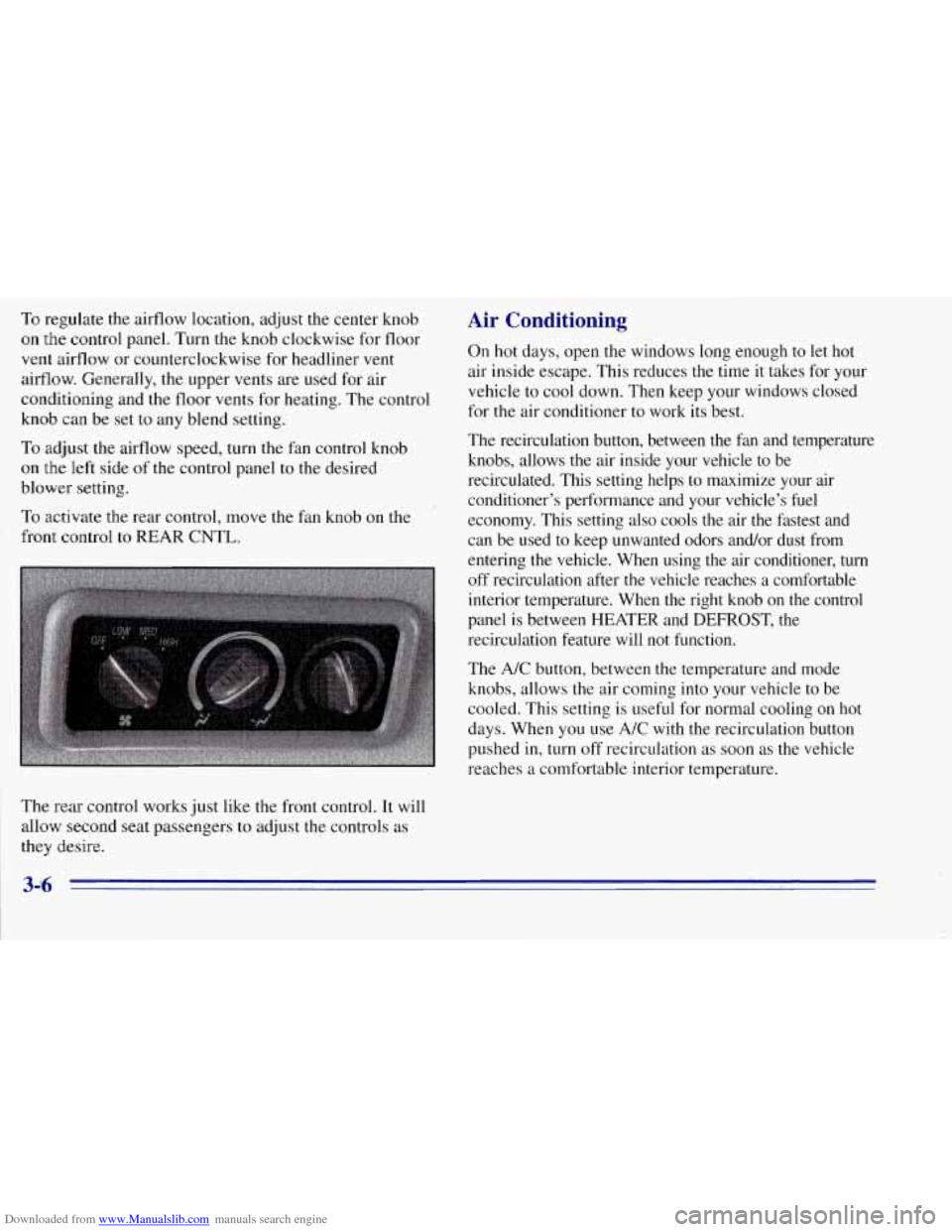
Downloaded from www.Manualslib.com manuals search engine To regulate the airflow location, adjust the center knob
on the control panel. Turn the knob clockwise for floor
vent airflow or counterclockwise for headliner vent
airflow. Generally, the upper vents are used for air
conditioning and the floor vents for heating. The control
knob can
be set to any blend setting.
To adjust the aifflow speed, turn the fan control knob
on the left side of the control panel to the desired
blower setting.
To activate the rear control, move the fan knob on the
front control
to REAR CNTL.
Air Conditioning
On hot days, open the windows long enough to let hot
air inside escape. This reduces the time it takes for your
vehicle to cool down. Then keep your windows closed
for the air conditioner to work its best.
The recirculation button, between the fan and temperature
knobs, allows the air inside your vehicle to be
recirculated. This setting helps to maximize your air
conditioner’s performance and your vehicle’s fuel
economy. This setting also cools the air the fastest and
can be used to keep unwanted odors and/or dust from
entering the vehicle. When using the air conditioner, turn
off recirculation after the vehicle reaches a comfortable
interior temperature. When the right knob on the control
panel is between HEATER and DEFROST, the
recirculation feature will not function.
The A/C button, between the temperature and mode
knobs, allows the air coming into your vehicle to be
cooled. This setting is useful for normal cooling on hot
days. When
you use A/C with the recirculation button
pushed in, turn off recirculation as soon as the vehicle
reaches a comfortable interior temperature.
The
rear control works just like the front control. It will
allow second seat passengers to adjust the controls as
they desire.
Page 138 of 403
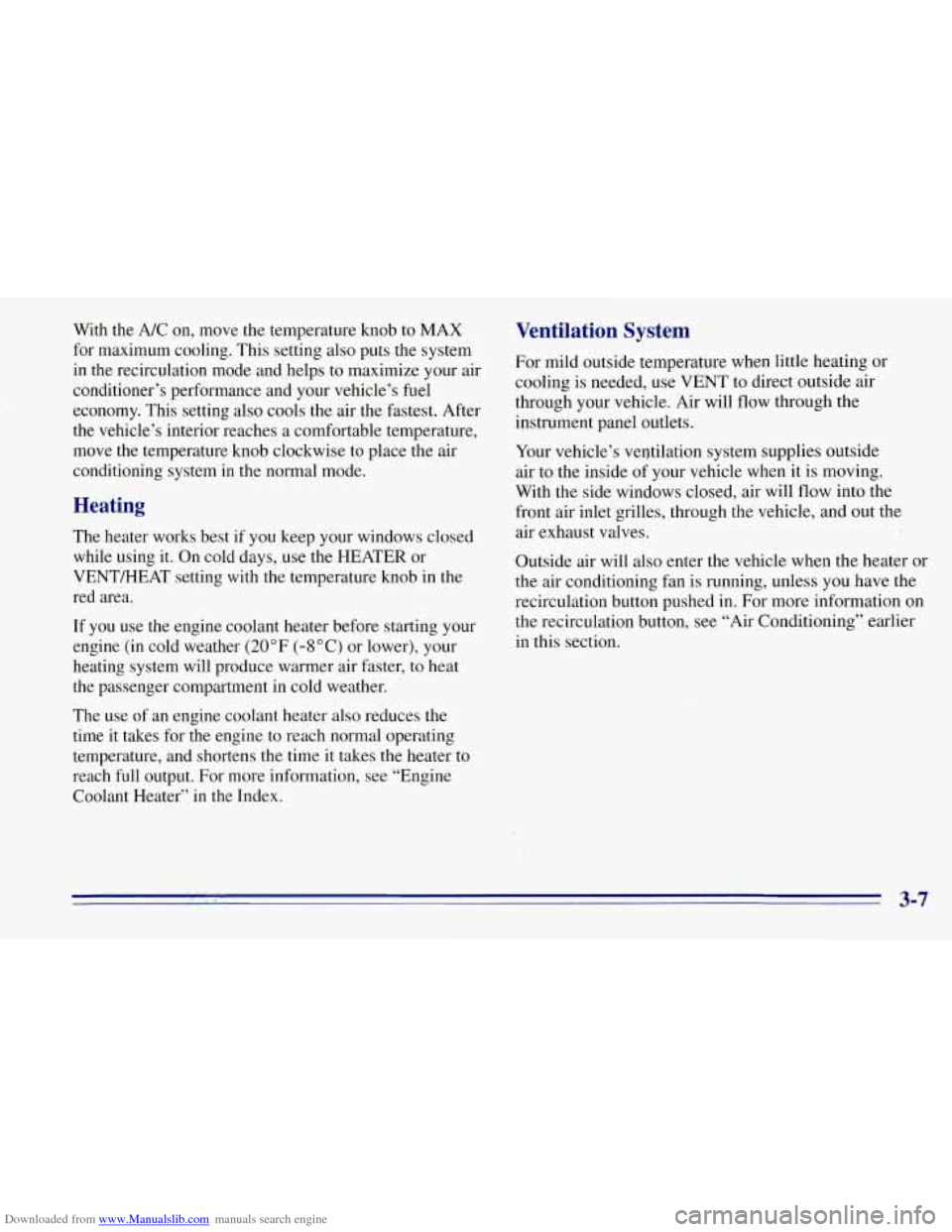
Downloaded from www.Manualslib.com manuals search engine With the A/C on, move the temperature knob to MAX
for maximum cooling. This setting also puts the system
in the recirculation mode and helps to maximize your air
conditioner’s performance and your vehicle’s fuel
economy. This setting also cools the air the fastest. After
the vehicle’s interior reaches a comfortable temperature,
move the temperature knob clockwise to place the air
conditioning system in the normal mode.
The heater works best if you keep your windows closed
while using it. On cold days, use the HEATER or
VENT/HEAT setting with the temperature knob in the
red area.
If you use the engine coolant heater before starting your
engine (in cold weather (20°F (-8OC) or lower), your
heating system will produce warmer air faster, to heat
the passenger compartment in cold weather.
The use of an engine coolant heater also reduces the
time it takes for the engine to reach normal operating
temperature, and shortens the time it takes the heater to
reach full output. For more information, see “Engine
Coolant Heater” in the Index. Ventilation System
For mild outside temperature when little heating or
cooling is needed, use VENT to direct outside air
through your vehicle. Air will flow through the
instrument panel outlets.
Your vehicle’s ventilation system supplies outside
air to the inside
of your vehicle when it is moving.
With the side windows closed, air will flow into the
front air inlet grilles, through the vehicle, and out the
air exhaust valves.
Outside air will also enter the vehicle when the heater or
the air conditioning fan is running, unless you have the
recirculation button pushed in. For more information
on
the recirculation button, see “Air Conditioning” earlier
in this section.
- .. G 3-7
Page 141 of 403
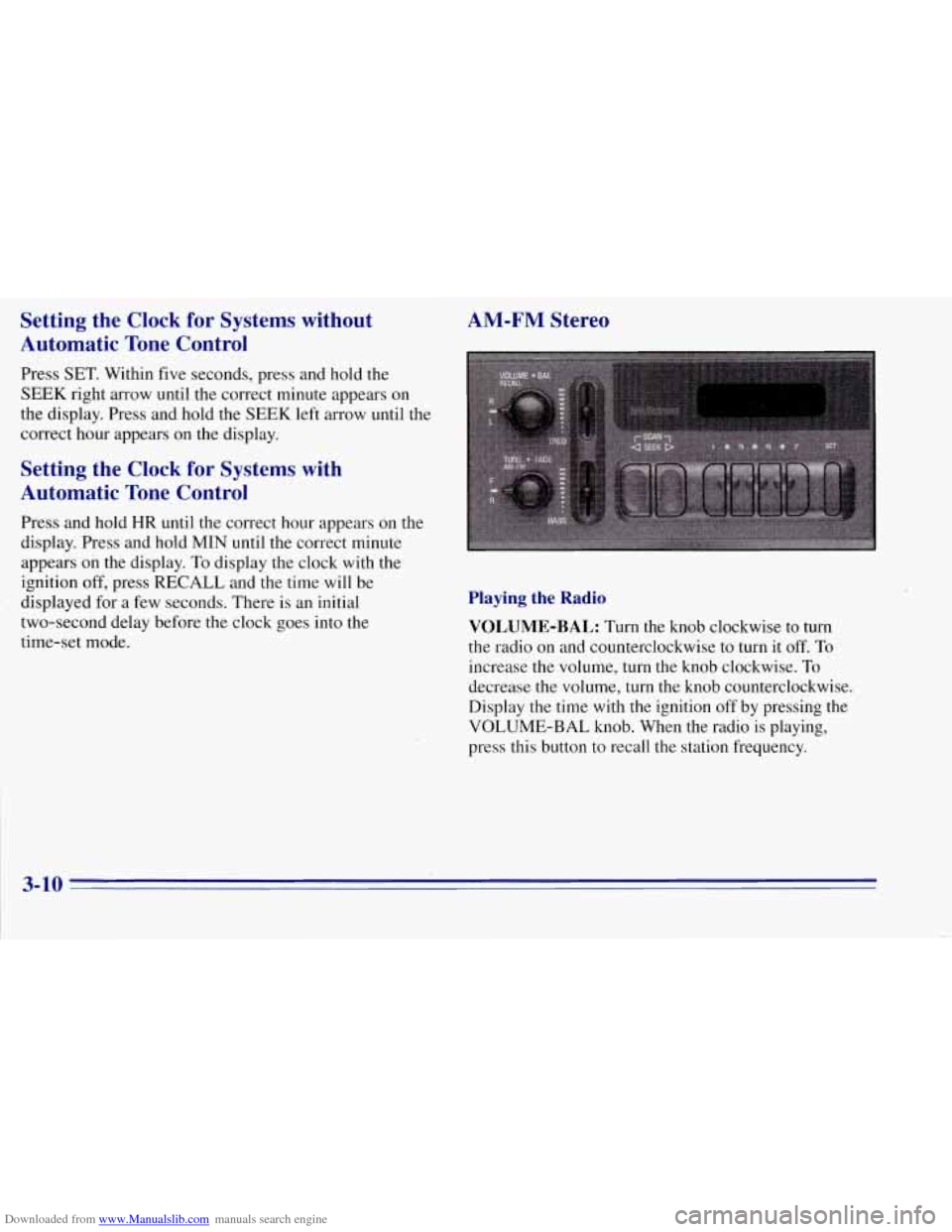
Downloaded from www.Manualslib.com manuals search engine Setting the Clock for Systems without
Automatic Tone Control
Press SET. Within five seconds, press and hold the
SEEK right arrow until the correct minute appears on
the display. Press and hold the SEEK left arrow until the
correct hour appears on the display.
Setting the Clock for Systems with
Automatic Tone Control
Press and hold HR until the correct hour appears on the
display. Press and hold MIN until the correct minute
appears on the display. To display the clock with the
ignition off, press RECALL and the time will be
displayed for a few seconds. There is an initial
two-second delay before the clock goes into the
time-set mode.
AM-FM Stereo
Playing the Radio
VOLUME-BAL: Turn the knob clockwise to turn
the radio on and counterclockwise
to turn it off. To
increase the volume, turn the knob clockwise. To
decrease the volume, turn
the knob counterclockwise.
Display the time with the ignition off by pressing the
VOLUME-BAL knob. When the radio is playing,
press this button to recall the station frequency.
3-10
Page 146 of 403
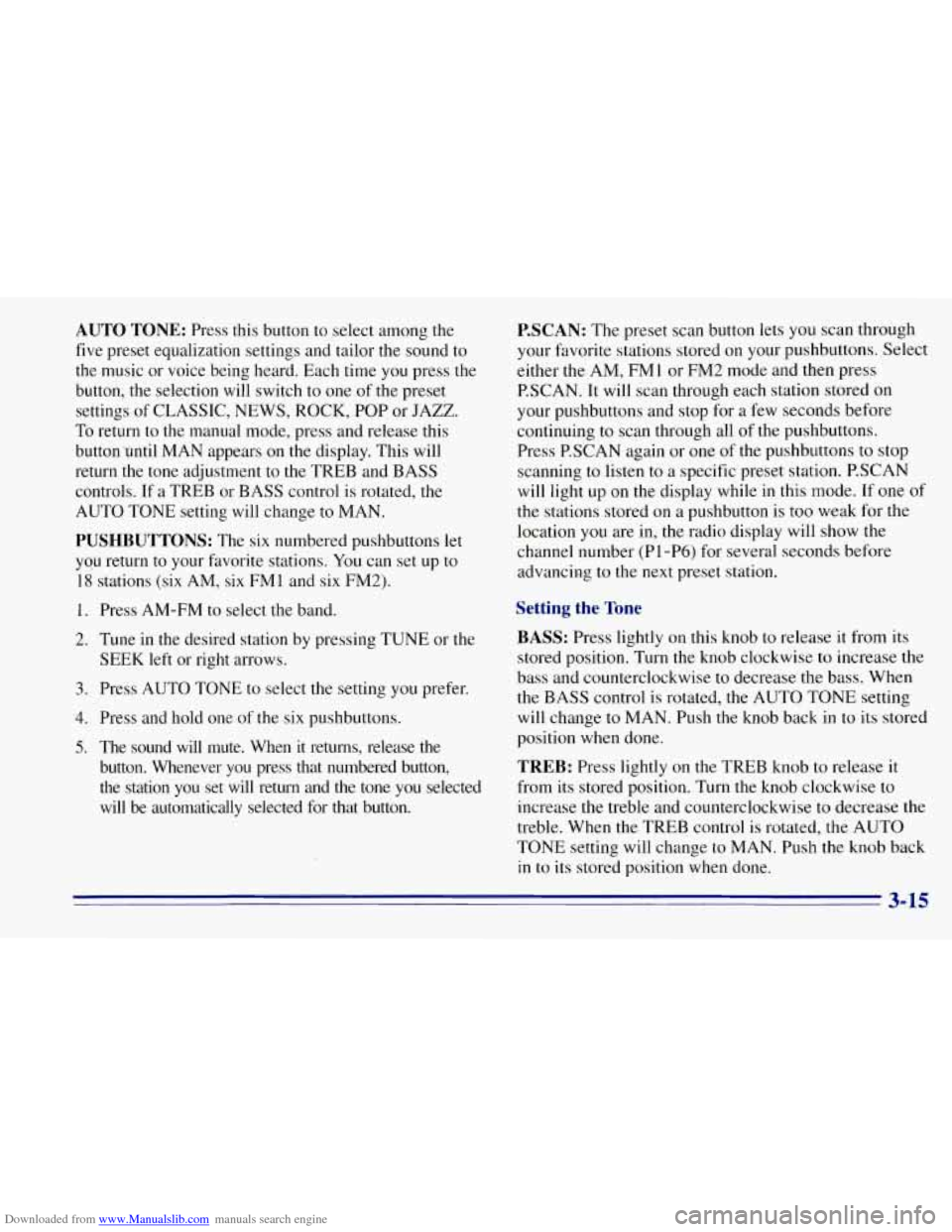
Downloaded from www.Manualslib.com manuals search engine AUTO TONE: Press this button to select among the
five preset equalization settings and tailor the sound to
the music
or voice being heard. Each time you press the
button, the selection will switch to
one of the preset
settings of CLASSIC, NEWS, ROCK, POP or JAZZ.
To return to the manual mode, press and release this
button'antil MAN appears on the display. This will
return the tone adjustment to
the TREB and BASS
controls. If a TREB or BASS control is rotated, the
AUTO TONE setting will change to MAN.
PUSHBUTTONS: The six numbered pushbuttons let
you return to your favorite stations.
You can set up to
18 stations (six AM, six FMl and six FM2).
1.
2.
3.
4.
5.
Press AM-FM to select the band.
Tune in the desired station by pressing TUNE or the
SEEK left or right arrows.
Press
AUTO TONE to select the setting you prefer.
Press and hold one of the six pushbuttons.
The sound will mute. When it returns, release the
button. Whenever you press that numbered button,
the station you set will return and the tone
you selected
will be automatically selected for that button.
P.SCAN: The preset scan button lets you scan through
your favorite stations stored on your pushbuttons. Select
either the AM, FMl or FM2 mode and then press
P.SCAN. It will scan through each station stored
on
your pushbuttons and stop for a few seconds before
continuing to scan through all of the pushbuttons.
Press P.SCAN again or one of the pushbuttons
to stop
scanning to listen to a specific preset station. P.SCAN
will light up on the display while in this mode. If one of
the stations stored on a pushbutton is
too weak for the
location you are
in, the radio display will show the
channel number (PI-P6) for several seconds before
advancing to the next preset station.
Setting the Tone
BASS: Press lightly on this knob to release it from its
stored position. Turn the knob clockwise
to increase the
bass and counterclockwise to decrease the bass. When
the BASS control is rotated, the AUTO TONE setting
will change to MAN. Push the knob back in
to its stored
position when done.
TREB: Press lightly on the TREB knob to release it
from its stored position. Turn the knob clockwise
to
increase the treble and counterclockwise to decrease the
treble. When the TREB control is rotated, the AUTO
TONE setting will change to MAN. Push
the knob back
in to its stored position when done.
3-15
Page 153 of 403
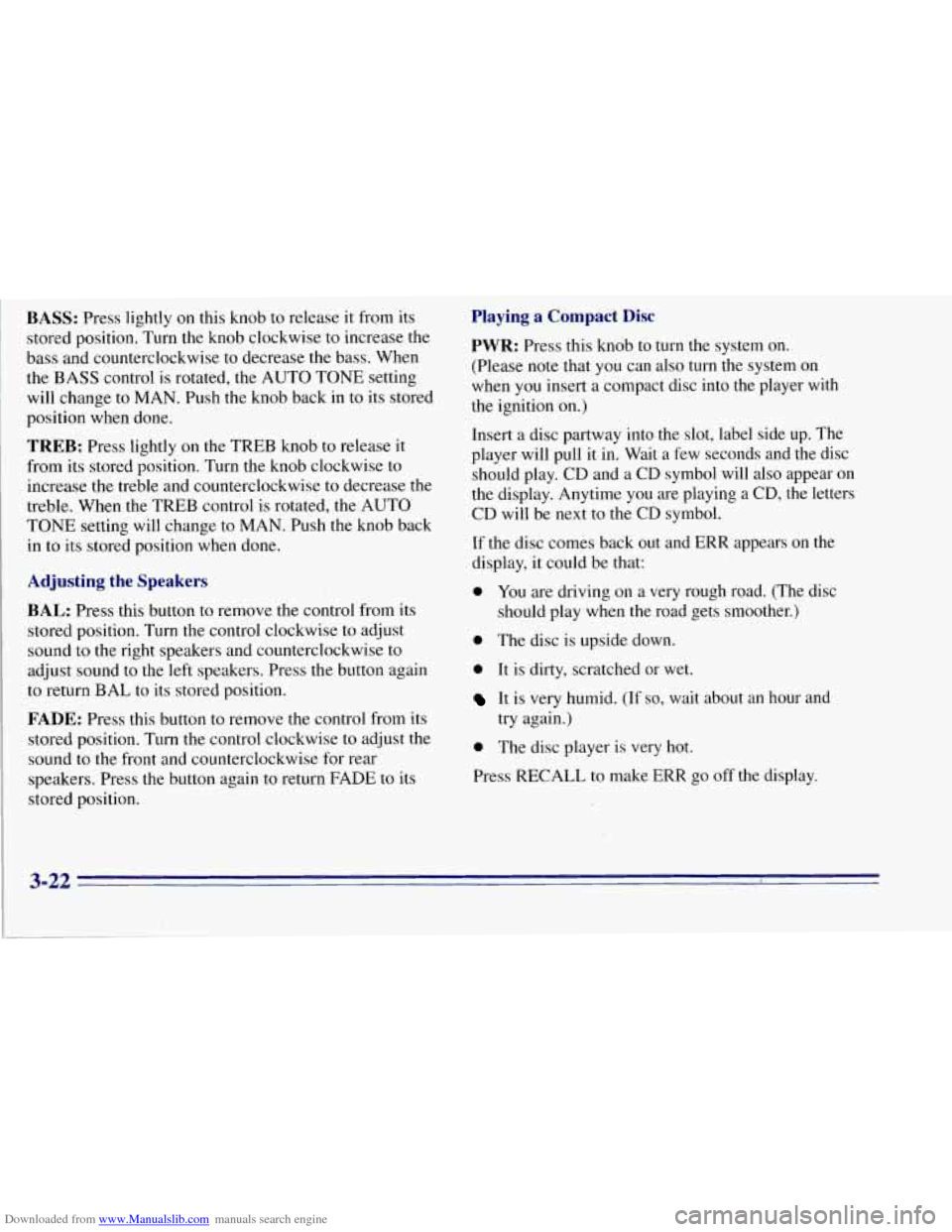
Downloaded from www.Manualslib.com manuals search engine BASS: Press lightly on this knob to release it from its
stored position. Turn the knob clockwise to increase the
bass and counterclockwise to decrease the bass. When
the BASS control is rotated, the AUTO TONE setting
will change to MAN. Push the knob back in to its stored
position when done.
TREB: Press lightly on the TREB knob to release it
from its stored position. Turn the knob clockwise to
increase the treble and counterclockwise to decrease the
treble. When the TREB control is rotated, the AUTO
TONE setting will change to MAN. Push the knob back
in
to its stored position when done.
Adjusting the Speakers
BAL: Press this button to remove the control from its
stored position. Turn the control clockwise
to adjust
sound to the right speakers and counterclockwise to
adjust sound to the
left speakers. Press the button again
to return BAL to its stored position.
FADE: Press this button to remove the control from its
stored position. Turn the control clockwise
to adjust the
sound
to the front and counterclockwise for rear
speakers. Press the button again to return FADE to its
stored position.
Playing a Compact Disc
PWR: Press this knob to turn the system on.
(Please note that you can also turn the system on
when you insert a compact disc into the player with
the ignition on.)
Insert a disc partway into the slot, label side up. The
player will pull it in. Wait a few seconds and the disc
should play. CD and a CD symbol will also appear on
the display. Anytime you are playing a CD, the letters
CD will be next to the CD symbol.
If the disc comes back out and ERR appears on the
display, it could be that:
0 You are driving on a very rough road. (The disc
should play when the road gets smoother.)
0 The disc is upside down.
0 It is dirty, scratched or wet.
It is very humid. (If so, wait about an hour and
try again.)
0 The disc player is very hot.
Press RECALL to make ERR go off the display.
3-22 P
Page 391 of 403
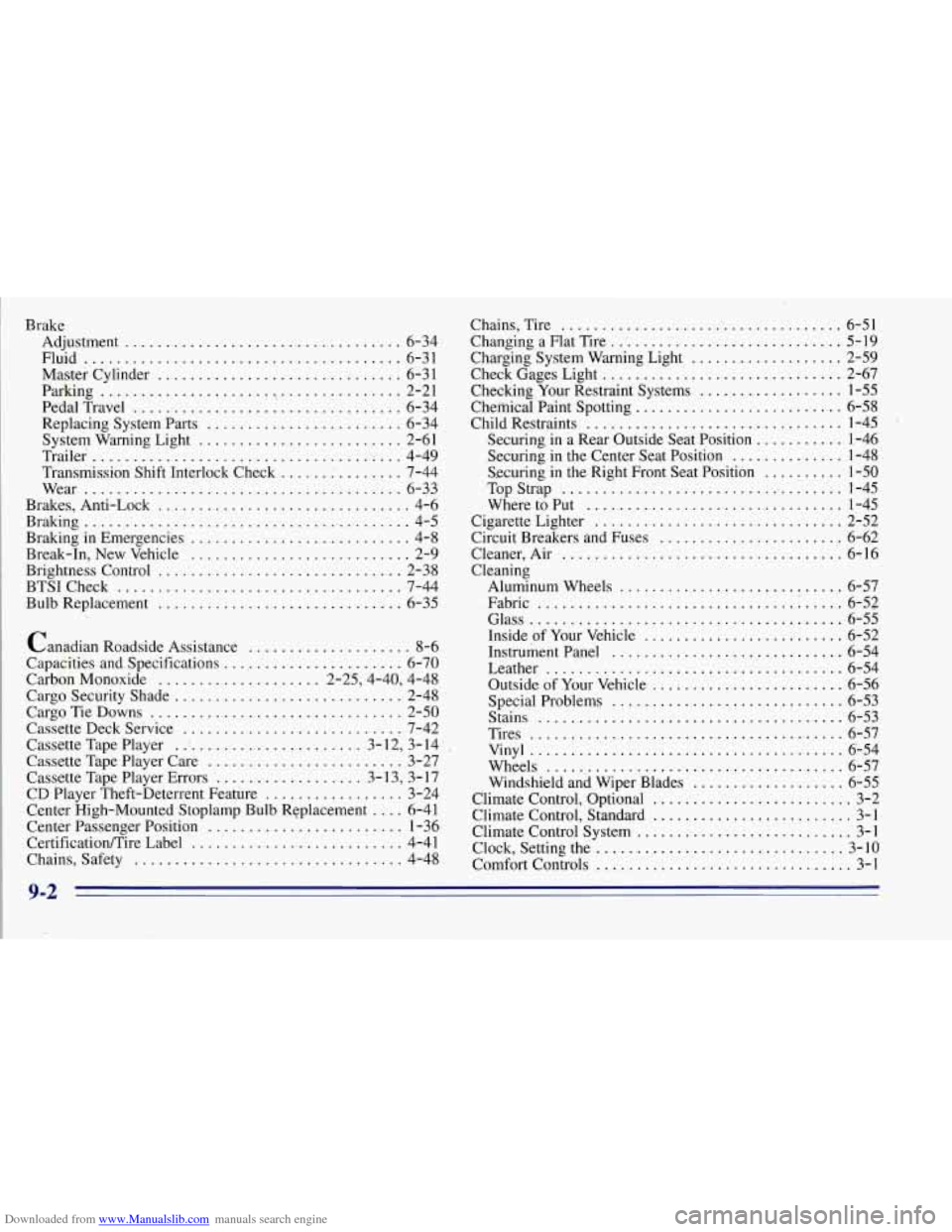
Downloaded from www.Manualslib.com manuals search engine Brake Adjustment
.................................. 6-34.
Fluid
....................................... 6-31
Master Cylinder .............................. 6-3 1
Parking ...................................... 2-21
PedalTravel
.................................. 6-34
Replacing System Parts
........................ 6-34
System Warning Light
......................... 2-61
Trailer
...................................... 4-49
Transmission Shift Interlock Check
...... : ........ 7-44
Wear
....................................... 6-33
Brakes, Anti-Lock
............................... 4-6
Braking
......................................... 4-5
Braking in Emergencies
........................... 4-8
Break-In, New Vehicle
........................... 2-9
Brightness Control
.............................. 2-38
BTSICheck
................................... 7-44
Bulb Replacement .............................. 6-35
Canadian Roadside Assistance
.................... 8-6
Capacities and
. Specifications ...................... 6-70
Carbon Monoxide
.................... 2.25.4.40, 4.48
Cargo Security Shade
............................ 2-48
Cargo Tie Downs
............................... 2-50
Cassette Deck Service
........................... 7-42
Cassette Tape Player
.. ' ..................... 3- 12. 3- 14
Cassette Tape Player Care
........................ 3-27
Cassette Tape Player Errors
.................. 3- 13. 3. 17
CD Player Theft-Deterrent Feature
................. 3-24
Center High-Mounted Stoplamp Bulb Replacement
.... 6-41
Center Passenger Position
........................ 1-36
CertificationEire Label
.......................... 4-41
Chains. Safety
................................. 4-48 Chains. Tire
.................................... 6-51
Changing a Flat Tire
................ .. ............. 5-19
Charging System Warning Light
................... 2-59
Check Gages Light
.............................. 2-67
Checking Your Restraint Systems
.................. 1-55
Chemical Paint Spotting
.......................... 6-58
Child Restraints
................................ 1-45
Securing in a Rear Outside Seat Position
........... 1-46
.Securing in the Center Seat Position
.............. 1-48
Securing
in the Right Front Seat Position .......... 1-50
Top Strap
.................................... 1-45
WheretoPut
................................ 1-45
Circuit Breakers and Fuses
........................ 6-62
Cleaner.Air
................................... 6-16
Cigarette Lighter
............................... 2-52
Cleaning Aluminum Wheels
............................ 6-57
Fabric
...................................... 6-52
Glass
........................................ 6-55
Inside
of Your Vehicle ......................... 6-52
Instrument Panel
.............................. 6-54
Leather
..................................... 6-54
Outside of Your Vehicle
........................ 6-56
Special Problems
............................. 6-53
Stains
...................................... 6-53
Tires
........................................ 6-57
Vinyl
....................................... 6-54
Wheels
..................................... 6-57
Windshield and Wiper Blades
................... 6-55
Climate Control, Optional
......................... 3-2
Climate Control, Standard
......................... 3-1
Climate Control System
........................... 3-1
Clock, Setting the
................................ 3-10
Comfort Controls
................................ 3-1
9-2